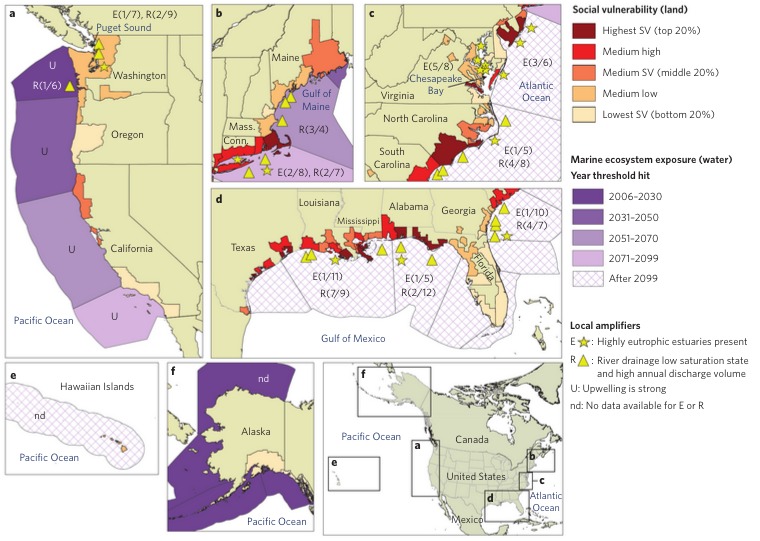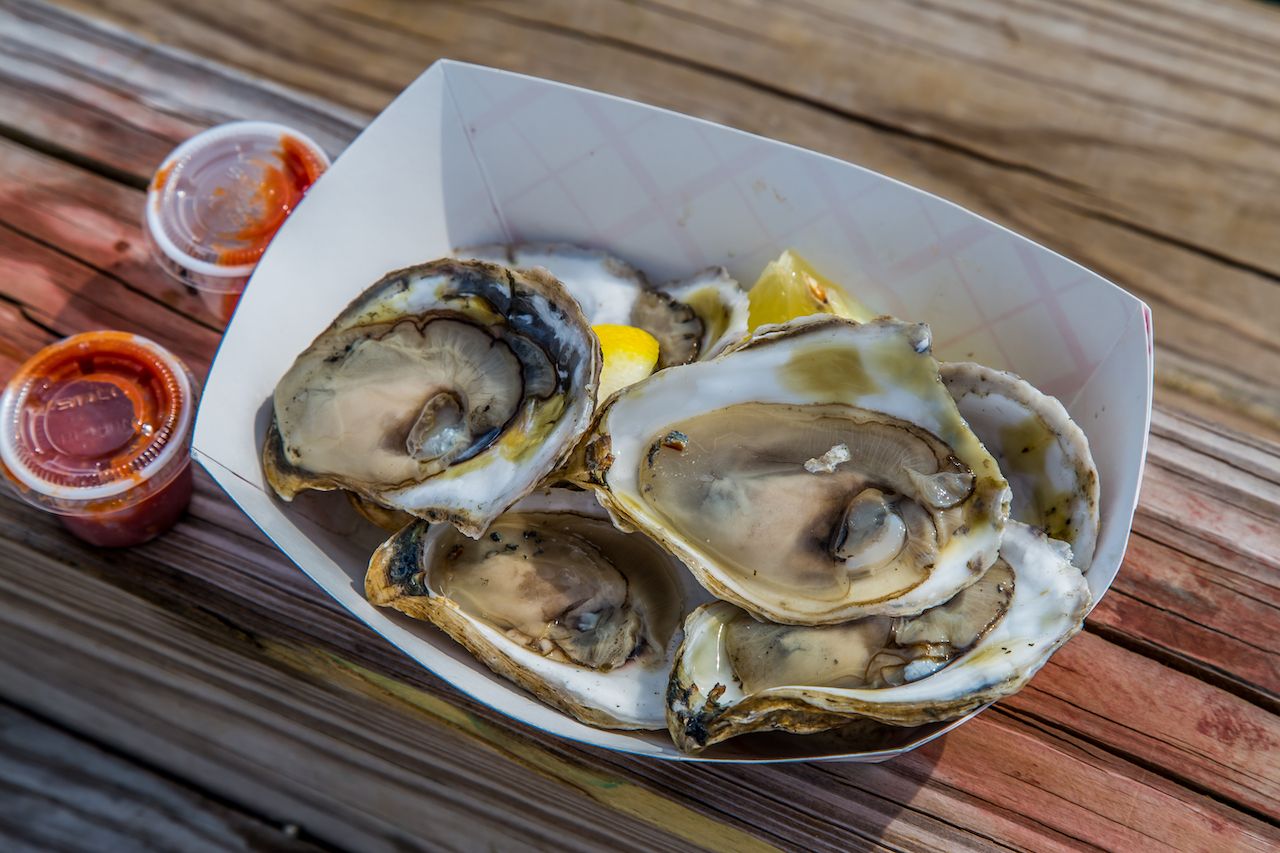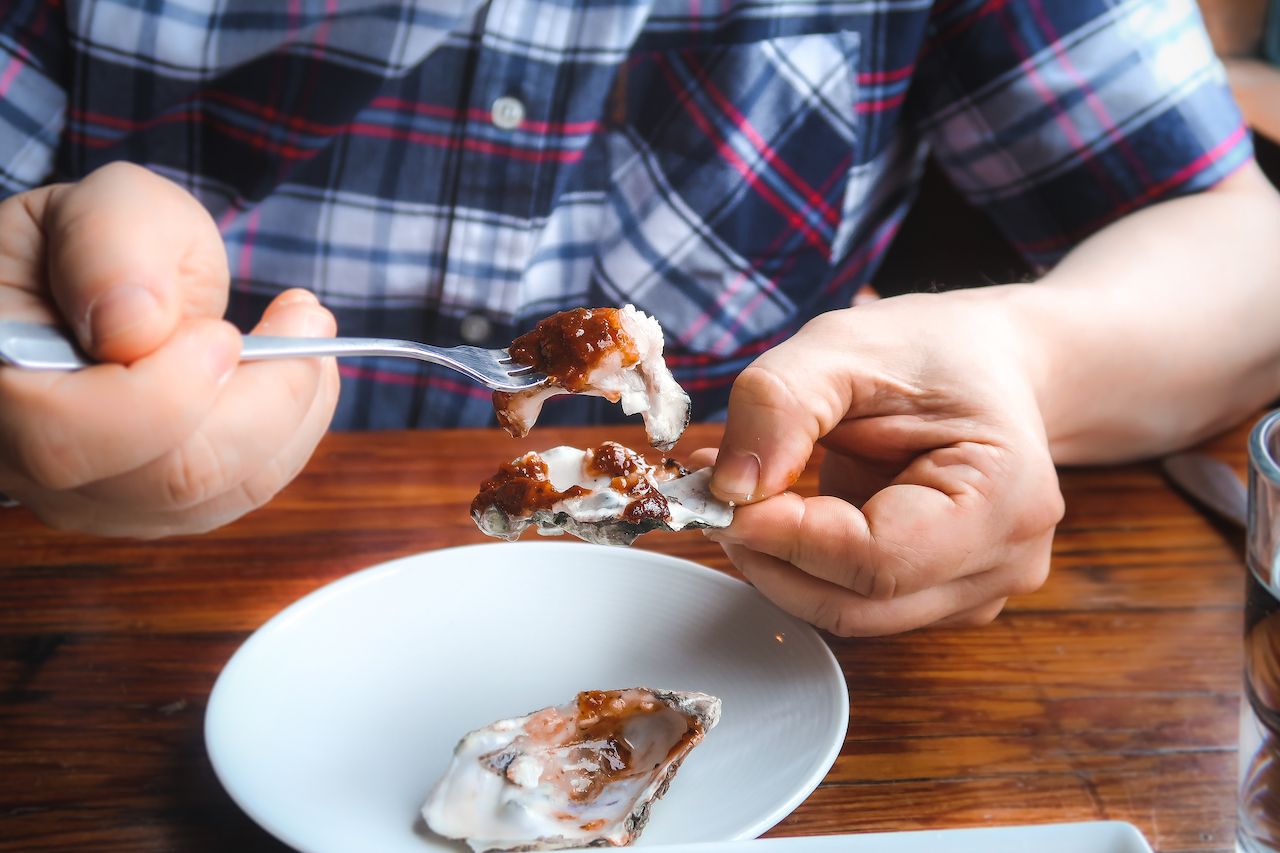Oysters look like they belong in the ocean, and it’s even more clear when the shell is taken off. It’s fair to say that the oyster is, at the very least, visually unappetizing.
Then the oyster touches your tongue. If it comes from a faraway inlet, it might taste like the clean water of that inlet or the rough waves of the ocean. You might taste the saltiness of seawood and the ocean floor, or you might taste something more metallic and mineral, like rocks that have been washed clean by strong currents. That’s not always the case. For example, the green rind of an unripe melon or the snap of a fresh cucumber can taste sweet and sour at the same time. The layered, fresh, and complex flavors are why oysters, despite their appearance, are considered a delicacy.
Oysters taste different depending on where they’re sourced from. In the United States, oysters bloom in huge groups along the coasts of Washington, California, Alabama, Maine, and other places. The diversity found in US waters gives other famous oyster countries, like France, a run for its money.
The executive chef at the French restaurant Avenue in Long Branch, New Jersey, says that American oysters have a different, lighter brininess than French oysters. “Cup sizes can vary.” “French oysters are milkier with a metallic flavor, are flatter, and have a little cup. ”.
Even though oysters can be grilled or fried, most people eat them on the halfshell with cocktail sauce, mignonette sauce made with vinegar and shallots, and fresh lemon wedges. If you don’t use too much cocktail sauce, these light, fresh dressings don’t take away from the oysters’ great flavors. Plain and raw foods are best to enjoy all of their natural flavors. To do this, wiggle the meat around, tilt your head back, and slurp. You should swallow the oyster in one bite, but if you want to really enjoy the brine, chew it a few times first.
You may have heard that oysters are only safe to eat in months that start with the letter “r.” It’s a complete myth. Oysters farmed in clean water and harvested hygienically are safe to eat all year around. A lot of people used to say that you shouldn’t eat oysters in the summer because they go bad faster. Wild oysters also spawn in the summer, leaving the meat thin and soggy. However, most oysters raised in aquaculture don’t spawn. Some oysters taste better in certain months, however, so do they have a prime season.
The best places to find oysters are, unsurprisingly, on the coasts. These are the essential oyster-bearing regions in America, plus the best oysters to eat in each one.
Oysters are one of the most popular shellfish in the United States. Their briny, ocean-fresh taste makes them a delicacy that is loved by many. But what state actually produces the most of these tasty bivalves? The answer may surprise you!
The Growth of Oyster Aquaculture
While oysters have been harvested from the wild for centuries, oyster farming (known as oyster aquaculture) has become increasingly important in recent decades. This is especially true on the East and West Coasts, where suitable natural oyster beds have declined.
Total oyster aquaculture sales reached $180 million in 2013 and $285 million in 2018. The growth of oyster farming has allowed the domestic production of oysters to rebound, even as wild harvests have decreased.
The Top Oyster Producing States
So which states lead the way in oyster aquaculture? Here are the top 5, based on the number of oyster farms:
1. Massachusetts
Massachusetts leads the nation with 151 oyster farms as of 2018. Major production areas include Cape Cod, Buzzards Bay and some areas around Boston. Wellfleet and Island Creek are two popular oyster varieties from Massachusetts. The state benefits from an abundance of shallow bays and estuaries that provide ideal conditions for raising oysters.
2. Virginia
Virginia comes in second with 134 oyster farms. Most production is focused in the Chesapeake Bay area, which has a long history of oyster harvesting. Popular varieties from Virginia include the Rappahannock, Lynnhaven, and Chincoteague oysters. Virginia is also working to restore wild oyster populations in the Chesapeake Bay through new artificial reefs.
3. Washington
Washington State is number three with 86 oyster farms. Major growing areas include Willapa Bay, Puget Sound, and Hood Canal. Washington is famous for oysters like the Shigoku, Olympia, Kumamoto, and Pacific. The state provides excellent conditions for oysters with its numerous bays, inlets, and river deltas along the Pacific Coast.
4. Maine
Maine takes the fourth spot with 42 oyster farms. The Damariscotta River is a major oyster producing area in the state. Glidden Points and Pemaquids are two of the most popular oysters from Maine. The cold, clean waters of the North Atlantic help give Maine oysters their famous briny taste.
5. North Carolina
Rounding out the top five is North Carolina with 33 oyster farms. Important production areas include Bogue Sound, Back Sound, Core Sound, and the Pamlico Sound. Well known oyster varieties from North Carolina include the Cape Fear, Bayeswater Sweet, and White Oak River oysters.
Other Notable Oyster Producers
While the top five states account for most US oyster production, other states also contribute:
-
Louisiana has just 19 farms but is known for its large, flavorful oysters from the Gulf Coast.
-
New York is also home to 19 oyster farms, mostly on Long Island where the famous Bluepoint oyster originates.
-
Alaska has 15 farms and is gaining notice for its sweet, merroir-driven oysters.
-
Rhode Island has 12 farms, producing oysters like Moonstones and Wequassetts in places like Narragansett Bay.
The Future of Oyster Farming
With the expansion of oyster aquaculture, oysters have become a booming business in many coastal states. The industry continues to innovate with new farming techniques, disease-resistant oyster strains, and value-added oyster products. This bodes well for oyster lovers, ensuring plentiful access to high-quality oysters harvested right here in the USA. Though small in size, the mighty oyster makes a huge economic and culinary impact from coast to coast.

Northeast and East Coast

On Cape Cod, Massachusetts, you’ll find an abundance of must-try oysters varieties, most notably WiAnno, Duxbury, and Wellfleet. Prime oyster season here tends to run from October to March.
Wellfleet oysters are salty with a clean finish, balanced by a touch of sweetness. Eat them plain or with a light spritz of lemon juice to cut down on the brininess. The meat of a Duxbery oyster is fatty and buttery, while WiAnno oysters are briny and sweet.
Cape Cod is home to many hidden oyster gems. Farm-raised varieties like the creamy Cotuit, which tastes very much like the ocean, and the Barnstable, which tastes salty with a sweet, seaweed-like finish, are worth mentioning.
Totten Inlet in the Puget Sound
Olympia oysters, also called Oly oysters, are the only oyster species native to Puget Sound waters. Found mostly in Totten Inlet in the Puget Sound, Olympias are also farmed in the nearby Eld Inlet (where the meat of the beach-grown oysters is buttery and tastes like watermelon rind to some) by Olympia-based Chelsea Farms.
Even though Olys are small (they rarely get bigger than a 50-cent coin), this oyster has made it through. They are no longer found in most of Puget Sound because of pollution and overfishing, but they live on there. Their flavor is bold and intense, perhaps best described as earthy, with a lingering, smoky aftertaste. Olys are highly briny, so be prepared to taste ocean.
Another popular variety from Totten Inlet is the Kumamoto oyster, which is originally from Japan. This oyster gained a following for its sweet taste, reminiscent of fresh honeydew melon, and a mild brininess. Oyster-eating amateurs will love Kumamotos alongside a splash of lemon juice or vinegary mignonette sauce.
“Nothing beats a Kumamoto,” Sauer says, “which has a deep cup, mild brine, and a creamy texture. At nearby Hammersley Inlet, the oysters are big and have a clean, light cucumber flavor that goes well with fresh lemons and cocktail sauce, which are usually served with oysters.
Oysters are so plentiful in Hood Canal that you can pick them up by the handful on the beaches. A friend with a cabin on Hood Canal tells me that “oysters out number rocks” in the area. Among the varieties that grow here are the super briny Summerstone and the smooth-shelled, crisp Blue Pool oyster, both grown and sold by the Hama Hama Company.
One of Hood Canal’s most famous oysters is the Hama Hama. They taste like cucumber and are slightly salty. They’re beach grown and accustomed to moving with the tides and shifting currents. Hamma Hamma River (yes, it’s spelled differently than the oyster) gives us millions of these oysters at a time, and Hama Hama Company also picks them. You can get Hama Hamas all year, just like most other oysters. In the spring, they are sweeter, and in the fall and winter, they taste saltier.

There are surprisingly few places to grow oysters in California. There aren’t enough bays in the state for oysters to do well. In the mid-1800s, San Francisco Bay was home to millions of oysters, but it’s now way too polluted for them to survive.
Yet tucked away in Marin County is an anomaly: Tomales Bay, home to Hog Island Oyster Co. Here, you’ll find the Hog Island Sweetwater, the bay’s signature oyster that’s farmed year-round. As the name suggests, these oysters are sweet with a smoky, metallic finish and mild brininess. At Hog Island (where you can plan a “shuck your own oyster picnic” at the nearby beach) you’ll also find French Hog oysters, which have a strong seaweed flavor, and Kumamotos like those from Totten Inlet.
In the cold, salty waters of Morro Bay, Pacific Gold oysters prosper. These fresh, bright oysters have a flavor that’s often compared to lemongrass or the green rind of a melon. Pacific Gold are the same variety as Hama Hama oysters, but the waters in Morro Bay make for a sweeter, saltier oyster once its mature. Though they can be eaten raw, Morro Bay Oyster Co., where they’re farmed, recommends grilling Pacific Gold oysters.
Another farmed oyster you’ll find in Morro Bay is the Grassy Bar, said to taste like fresh watermelon and sea water.
How 3.5 Million Oysters Are Harvested At This Virginia Farm Every Year | Big Business
FAQ
Where do most oysters come from in the US?
What state is most known for oysters?
Who is the largest producer of oyster?
How many oyster farms are there in the US?
Where do Alabama oysters come from?
Even though Alabama only has 60 miles of coastline, the state is one of the leading producers of oysters in the U.S., with great examples coming from sites like Dauphin Island and Bayou La Batre. In the Bayou La Batre area on the gulf, look out for Murder Point Oysters, which have a rich and creamy texture.
Are Alabama oysters fat?
Salty and rich, Alabama oysters are among the most beloved in the country. In fact, the state was once the number one oyster producer in America. Like Louisiana oysters, Alabama oysters are triploids, so a farmed oyster like Isle Dauphin stays fat throughout the year.
Is Alabama a good place to eat oysters?
In fact, the state was once the number one oyster producer in America. Like Louisiana oysters, Alabama oysters are triploids, so a farmed oyster like Isle Dauphin stays fat throughout the year. The deliciously buttery and salty Murder Point are another Alabama favorite.
Where do the best oysters come from?
An abundance of oyster farms and natural reefs trace the coastlines of the South, producing some of the country’s highest-quality Eastern oysters (or Crassostrea virginica ).
